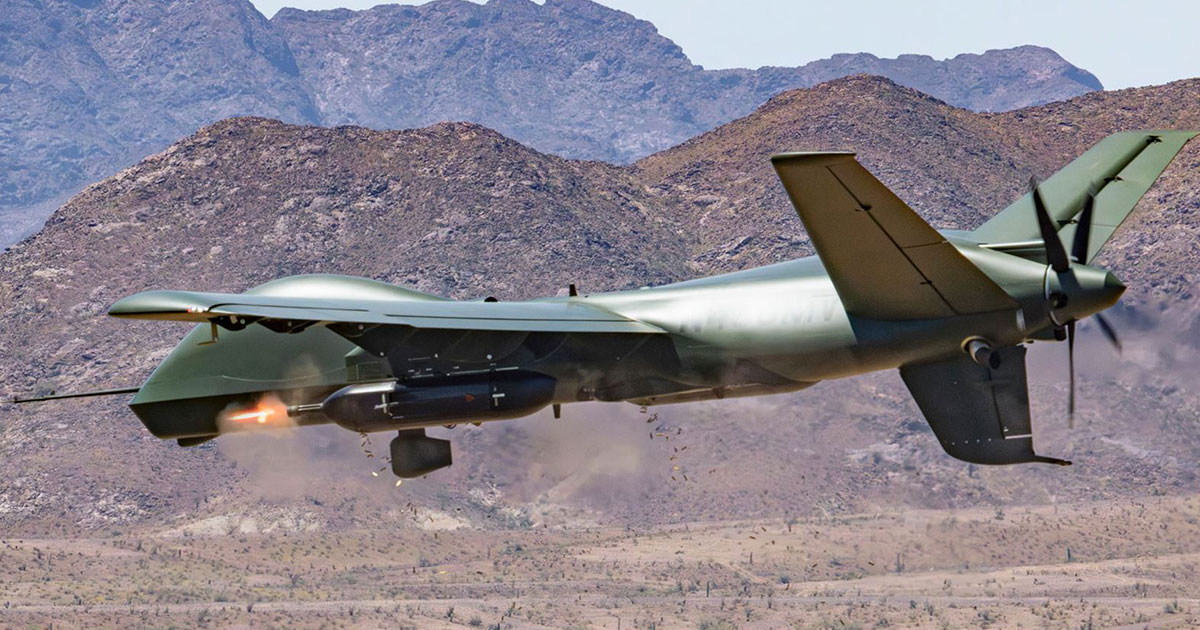Mojave Proves Its Unmatched Versatility in Unprecedented Live-Fire Demo
Mojave has made aviation history again.
The short takeoff and landing unmanned aircraft demonstrator, built by General Atomics Aeronautical Systems, Inc., already has set new milestones in getting airborne or returning to the surface. Now the aircraft has added a midair achievement: destroying its first targets.
In mid-April the Mojave conducted a series of live-fire tests at the U.S. Army’s Yuma Proving Ground, Arizona, marking the first time this aircraft has released ordnance of any kind and one of the rare times that any aircraft of this variety has used the type of weapon involved: a 7.62mm caliber minigun.
Specifically, Mojave was equipped with two Dillon Aero DAP-6 gun pods on a pylon under each wing. Each pod includes a six-barrel M134D-H rotary machine gun capable of firing around 3,000 rounds per minute.
GA-ASI test engineers worked with Dillon Aero’s armorers and aeronautical specialists to integrate the gun pods in a demonstration funded by GA-ASI’s internal research and development. The goal was to validate that the Mojave test aircraft could take on virtually any new payload – and that it could put steel on target.
“Seeing our Mojave perform this live-fire demo really emphasizes the versatility of the Mojave UAS and what it can do,” said GA-ASI President David R. Alexander. “Mojave has the ability to act as a sensor, shooter, and sustainer while mitigating threat environments and vulnerabilities and safeguarding human lives.”

Over seven passes across two flights during the demonstration, the Mojave fired around 10,000 rounds at a variety of static targets, mostly old vehicles, set up on the Yuma range.
The flights not only reaffirmed that Mojave can take on any number of new missions with a relatively short and simple period of engineering integration; they confirmed that the aircraft’s remote pilots can use it to attack at low altitudes.
“We’ve been flying medium-altitude, long-endurance unmanned systems for a long time, and they have used munitions against both air and surface targets. But usually, those munitions break away from the aircraft and close the distance using their own onboard guidance electronics and propulsion,” said a GA-ASI engineer involved with the tests. “With these flights we’ve shown these aircraft also can shoot many unguided rounds, if they need to, and put them where they need to go.”
The demonstrator Mojave aircraft is a slightly modified version of the U.S. Army’s mainstay Gray Eagle unmanned aerial system. It has a different wing and tail assembly and sacrifices some airborne endurance in order to reduce ground roll for takeoff and landing as compared with the legacy aircraft.
Mojave’s earlier accomplishments include unprecedented rough-field and dirt short takeoff and landing operations and first-of-their-kind flight operations aboard the British aircraft carrier HMS Prince of Wales. The aircraft represents a low-risk bridge for the U.S. Army or other users to get from the familiar, existing Gray Eagle to a new Gray Eagle STOL configuration.
One advantage of the system is that it’s well understood and proven. Another is that Gray Eagle STOL offers both runway independence – because it can fly from dirt, grass, a ship, a neighborhood soccer field, or similar – and also full-featured onboard sensing and communications and highly relevant range and endurance. Vertically launched or tube-fired unmanned systems can’t carry a great payload, don’t offer much onboard capability, and can’t stay aloft for the same periods of time.
Gray Eagle STOL offers the ability to tackle one of the Army’s toughest emerging missions: contested logistics. In a potential future battlefield, American and allied troops may need to be resupplied in or through areas contested by enemy forces. Gray Eagle STOL enables those missions with a variety of new capabilities that don’t require risking a human pilot and crew aboard the aircraft.
Gray Eagle STOL might fly from a friendly airbase equipped with cargo for friendly forces as well as air-to-ground weapons. During its flight, the aircraft can provide high-quality intelligence, surveillance, reconnaissance, or target acquisition – and take action against hostile forces if necessary. Then, it could land on a section of beach, or in a grass field, drop its cargo, and take off again to provide security for the friendly forces or contribute in some other way to allied operations.
If the mission requirements change, no problem – Mojave’s live-fire test proves, again, that these aircraft are as capable and as adaptable as needed.